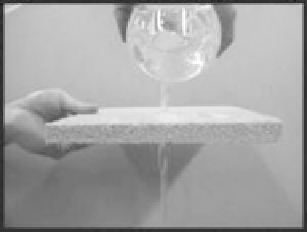Environmental Engineering Reference
In-Depth Information
FIGURE 31.5
Water low in a porous plate.
an iron powder as a iller, creating iron foam with a surface area of ~15 m
2
/g and a density
of ~0.3 g/cm
3
.
This method of producing media develops a hierarchical structure of open intercon-
nected porosity and provides extensive surfaces for deposition of active substances. An
openness to water or gas low exists at a low pressure drop (Figure 31.5). It also provides
great lexibility in shape and size of the media for integration into systems. Composition
can be adjusted to suit an application.
The high surface area of the porous structure is an ideal platform for active materials.
These include (i) beneicial bacteria for bioremediation, (ii) nanomaterials to capture or
breakdown contaminants, or (iii) anionic and cationic surfactants to capture contaminants
such as perchlorates. Characteristics include
• High surface area:
100× higher than most competitive media
• Highly porous:
~80% with a pore hierarchy that enhances turbulent liquid low
• Water readily lows:
through media at low pressures
• Available in various physical forms:
monoliths, pellets, granular
• Composition can be adjusted:
to provide enhanced chemical reactivity
• Fast reaction rates:
using nanomaterials
• Cost-effective:
for most applications
31.4.2 Nanomodification
Nanomaterials are used in the Meta-PO4 media to provide large numbers of sites for sorp-
tion of phosphorus compounds. FeOOH crystals are excellent in capturing phosphate and
some metal ions. Iron is known to remove phosphorus but Meta-PO4 performance is sig-
niicantly enhanced by a high concentration of nano-FeOOH crystals grown on the iron
foam surfaces. Surface area is >70 m
2
/g, and >10 wt% of nano-iron compounds are added
during the modiication process, which are easily accessed through interconnected poros-
ity. Surface area and interconnecting pores are shown in Figure 31.6a and the high concen-
trations of 20-40 nm acicular crystals in Figure 31.6b.
During use, phosphate ions are adsorbed onto the surface of the FeOOH nanoparti-
cles. In most cases, any FeOOH present will slow adsorption kinetics owing to diffusion
resistance and, consequently, their separation from aqueous solutions after adsorption is

